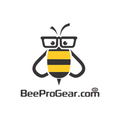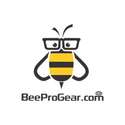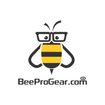For many, the sight of a beehive hanging from a tree branch is a beautiful, yet slightly intimidating, spectacle of nature. For a professional beekeeper, it's a unique challenge—a puzzle of skill, precision, and respect for the honeybee. Unlike a managed hive, a wild colony in a tree presents its own set of complexities, from the precarious position to the irregular comb structure. This isn't just about a honey harvest; it's a delicate rescue mission that requires the right knowledge, the right tools, and an unwavering commitment to Beekeeping Safety Practices. This comprehensive guide, brought to you by beeprogear, will walk you through the essential Beekeeping Techniques and Honey Harvesting Methods required for Tree Beehive Harvesting, ensuring a safe and successful outcome for both you and the bees.

The Essential Gear for the Professional Beekeeper
Before you even consider climbing that ladder, your first priority must be safety. The right equipment is the foundation of any successful Tree Hive Honey Collection. A professional beekeeper never compromises on gear.
- The Beekeeping Suit: A high-quality beekeping suit is your first and most important line of defense. It's not just a piece of cloth; it's a shield designed to protect you from stings and allow you to work with confidence. At beeprogear, our suits are made from durable, breathable materials with secure seals at the wrists, ankles, and veil. This prevents any unwanted access for the bees, allowing you to focus on the task.
- Gloves and Boots: Heavy-duty leather gloves and high-top boots are crucial. Gloves should be long enough to overlap the suit sleeves, and boots should be able to withstand uneven terrain and provide a solid footing.
- The Smoker: A reliable smoker is non-negotiable. The smoke calms the bees by disrupting their alarm pheromones, making them less defensive. Always have your smoker ready and filled with a fuel source like cotton or dried leaves.
- Specialized Tools: You will need a variety of tools to manage the hive safely. This includes a sharp knife for cutting the comb, a hive tool for prying, a soft bee brush for gently moving bees, and a sturdy container (a nuc box or a small hive box) to place the transferred hive.
- Ladder and Ropes: For Tree-Hanging Beehives, a stable and secure ladder is a must. A rope or pulley system is highly recommended to safely lower the heavy hive box once the transfer is complete.
The Art of Reconnaissance – Planning Your Approach
A professional beekeeper never rushes. The most critical part of Safe Honey Removal is the planning phase.
- Observe and Assess: Spend time observing the hive from a distance. Note its size, the number of bees, and its exact location on the branch. Are there any potential hazards like thin branches or other obstacles? The more information you have, the better your plan will be.
- Timing is Everything: The best time for Tree Hive Honey Collection is in the late afternoon or early evening. This is when the majority of the foraging bees have returned to the hive, ensuring you capture the entire colony, including the queen.
- Find the Queen: While not always possible to spot her immediately, knowing the queen's location is a huge advantage. Her presence guarantees the rest of the bees will follow her into the new hive.
- Communicate with Your Team: If you are not alone, establish clear communication signals. Professional Beekeeping Tips always emphasize teamwork and a clear understanding of roles.
Executing the Transfer – The Step-by-Step Guide
With your gear and plan in place, it's time to ascend. This is where your Beekeeping Techniques are put to the test.
- Ascend with Caution: Climb the ladder slowly and deliberately, always ensuring you have a firm grip and stable footing. It's best to have a partner to stabilize the ladder.
- Smoke Gently: Once you are at a safe working distance, gently puff smoke around the hive. Aim the smoke at the entrance and across the top of the hive. This will calm the bees and prepare them for the transfer.
- The Cut: Using a sharp knife, carefully cut the comb away from the branch. Be prepared for the weight of the honey and brood. Gently place the cut pieces of comb into the new hive box. Secure the comb with rubber bands to the frames if you can; this gives the bees a head start on rebuilding their home.
- Transfer the Bees: The goal of a Bee Hive Harvesting Guide is always to get the queen into the new box. Once the comb is in place, gently brush the remaining bees from the branch into the box. A light shake of the branch can also dislodge the rest of the cluster into the new home.
- Lowering the Hive: Once the majority of the bees are in the box, carefully secure the entrance with a screen or tape. Use your rope system to safely lower the heavy box to the ground. Never attempt to carry the box down the ladder, as this is a significant safety risk.
The Post-Harvest Care – Ensuring a New Beginning
Your job isn't done once the hive is on the ground. A professional beekeeper ensures the colony thrives in its new environment.
- Relocation: The new hive must be moved to a permanent location in your apiary. This location should be at least three miles away from the original tree to prevent the bees from returning to their old home.
- Feeding: The transferred colony has undergone significant stress and may not have enough honey stores to survive the transition. Providing them with a sugar syrup feeder will give them the energy they need to build new comb and establish themselves in their new home.
- Monitoring Health: As part of How to Harvest Honey Safely, it’s crucial to monitor the new hive for signs of stress, disease, or pests. Check for the queen’s egg-laying patterns and ensure the hive is building comb. Wild bees can carry mites and diseases, so a proper inspection is a must to protect your entire apiary.
Conclusion: A Commitment to Sustainable Beekeeping
Successfully removing and transferring a Tree-Hanging Beehive is a rewarding experience that highlights the importance of professional Beekeeping Techniques. It’s a delicate dance of skill and respect, where your safety and the bees' well-being are the top priorities. By following this Bee Hive Harvesting Guide, you’re not only getting a taste of nature's sweetest reward but also contributing to the conservation of these vital pollinators.
At beeprogear, we are committed to equipping beekeepers with the best tools and knowledge to practice this ancient craft safely and sustainably. Our products are designed for durability, comfort, and protection, so you can focus on the bees and your passion.
Ready to gear up for your next beekeeping challenge? Don’t compromise on safety or quality. Visit Beeprogear.com today to browse our full range of professional beekeeping suits, gloves, smokers, and tools. From novice beekeepers to seasoned experts, we have everything you need to practice beekeeping with confidence. Your passion for honey deserves the best gear. Shop now and start your next beekeeping adventure!


